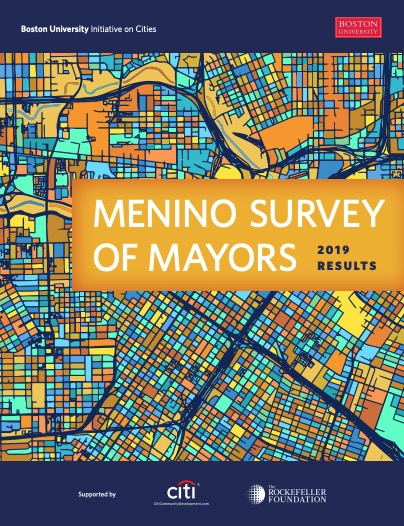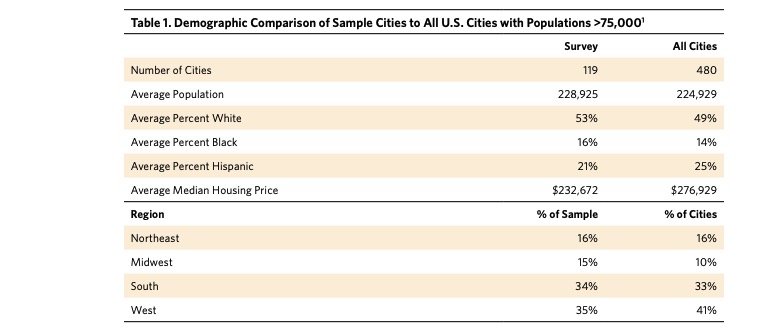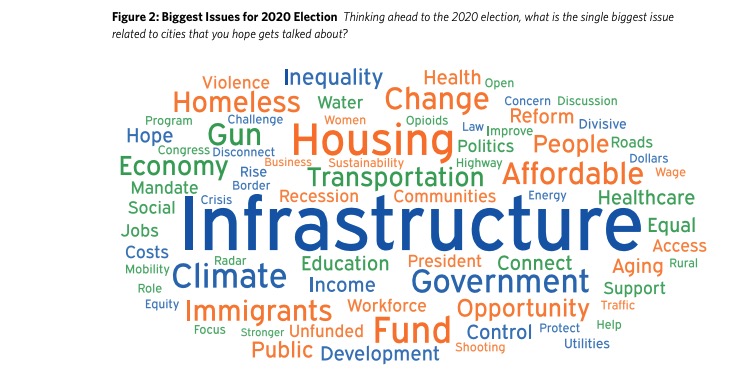BOSTON UNIVERSITY INITIATIVE ON CITIES
Executive Summary
INFRASTRUCTURE PRIORITIES
Mayors report water, wastewater, and stormwater are more of a priority relative to prior survey years, while road infrastructure and mass transit continue to be key needs.
One out of two mayors cited infrastructure as the issue they would like addressed in the upcoming presidential election. It was the most popular response by 30 percentage points. Other frequently cited issues were housing affordability (15 percent) and climate change (11 percent). Two-thirds of mayors highlighted roads as one of their top three infrastructure priorities, followed by water, wastewater, and stormwater (51 percent) and mass transit (43 percent). While these findings are similar to those in the 2015 Survey, mayors were 10 percentage points more likely to underscore water, wastewater, and stormwater in 2019 compared to 2015. Additionally, when mayors were asked to pick one “big ticket” investment they would prioritize if given unrestricted funds, water, wastewater, and stormwater topped the list (25 percent), followed by mass transit (19 percent) and roads (16 percent). The refurbishment or construction of city facilities and buildings was the chief “small ticket” priority named.
MOBILITY AND PUBLIC SAFETY
A significant proportion of mayors are concerned with the safety of cyclists and pedestrians in their communities, and have introduced a variety of design changes to improve it.
Nearly half of mayors believe travel for cyclists in their cities is unsafe and nearly 40 percent are concerned about pedestrians’ safety. In contrast, fewer than 10 percent believe the city is unsafe for drivers or mass transit riders. Two-thirds of mayors have implemented bicycle lanes to improve cyclist safety, while pedestrian upgrades include a more variable array of changes from improved sidewalks to traffic signalization. Mayors may not yet realize the extent to which vehicular speeds are a key lever to promote safety; 77 percent of mayors believe speed limits in their community are generally set at the right level, 56 percent believe enforcement is adequate, and 52 percent reject the idea of stronger moving traffic violations.
CAR CULTURE
Mayors believe their cities are too dependent on cars and embrace some reallocation of the roadway, particularly toward bicycle and electric vehicle infrastructure; however, they do not support other policy changes that can reduce car usage, such as higher prices for parking or lower off-street parking requirements in new development.
A significant majority of mayors (76 percent) report that their cities are too oriented towards cars and 66 percent believe vehicles are the largest source of greenhouse gas emissions in their communities. Seventy-one percent of mayors believe cities should make their roads more accessible to bicycles, even if it means sacrificing driving lanes or parking. However, mayors in the aggregate, do not perceive parking as oversupplied. Sixty percent say that their cities feature the right level of street parking; only nine percent believe that there is too much street parking. A far larger share — 27 percent — worry that there is too little parking in their cities. Additionally, half of mayors interviewed believe their parking minimums for new developments are set at the right level, while 30 percent perceive them as too high.
CLIMATE CHANGE
While a majority of mayors continue to believe cities should take action on climate change, opinions continue to be split along partisan lines.
Seventy percent of mayors believe their cities should play a strong role in reducing the effects of climate change, even if it means sacrificing revenue or expending financial resources; these levels have remained consistent over the last two years of the survey. Partisan divides endure with 25 percent of Republican mayors supporting climate action relative to 92 percent of Democratic mayors. One area of greater potential agreement is with regard to electric vehicles: 78 percent of Democratic mayors support sacrificing parking to improve electric vehicle charging infrastructure, compared to 40 percent of Republicans, although the latter were more likely to be neutral (33 percent.) While far from partisan agreement, fewer Republicans oppose the electric vehicle tradeoff than oppose the climate change tradeoff in general.
CHANGING NATURE OF WORK
Mayors expect high tech and health related jobs to grow, but also believe retail and manufacturing jobs will become less common.
Mayors expect that high tech jobs and jobs in health care and medicine, particularly those that serve the needs of an aging population, will experience significant growth in their communities in the next five years. They expect retail and manufacturing jobs to become less common, and foresee a general loss of manual jobs to automation. Mayors are nevertheless focused on expanding opportunities for their residents and report a wide array of targeted workforce development initiatives; the most common existing programs target youth (79 percent), followed by programs that serve persons with criminal records (52 percent) and ethnic minorities (50 percent).
OPPORTUNITY ZONES
Many mayors, across party lines and city attributes, have favorable impressions of the federal Opportunity Zones program and have high hopes for its ultimate impact on their cities. They believe that dedicated senior staff and an investment prospectus will be key to the program’s success locally.
Mayors generally believe the new federal Opportunity Zones program has targeted the right areas, both nationally and in their own communities. Roughly three quarters of cities in the survey sample had eligible census tracts and two-thirds now have at least one designated opportunity zone with an average of six per city. Mayors believe that designations were chiefly driven by a desire on the part of governors to spread them across the state, and were responsive to mayors’ input. More than half believe the program will have a large and positive impact on their local economy and that the main mechanisms needed to maximize the benefits are dedicated senior staff in city hall (54 percent) and an Opportunity Zone Investment Prospectus that outlines their community’s priorities and specific opportunities and assets (50 percent). Most (55 percent) have tasked their Economic Development Director, or a comparable role in that department, with the job of leading city efforts around opportunity zones.
METHODOLOGY: 119 SURVEY INTERVIEWS
The 2019 Menino Survey of Mayors uses a combination of open- and closed-ended questions to explore myriad, salient local issues and policy priorities. This year, 119 mayors discussed everything from infrastructure and transportation, to workforce development, to the Opportunity Zones program. To generate a systematic sample, we invited all mayors of cities with 75,000 or more residents to participate. Each mayor received an email invitation from the Boston University Menino Survey of Mayors team at their official email account, and follow-up phone calls. The vast majority of interviews were conducted in person or over the phone. This systematic sampling and recruitment effort yielded a representative sample of mayors of American cities with populations over 75,000. Table 1 compares the demographics of participating cities to all cities with over 75,000 residents.
INFRASTRUCTURE PRIORITIES
The 2020 presidential candidates have debated a wide gamut of issues, ranging from health care, to immigration, to impeachment proceedings. While many of these issues are critical to the day-to-day lives of the American people, there are several other key concerns — like infrastructure, climate change, and gun violence — that are of central importance to mayors and American cities. We asked mayors what issue related to cities they hoped would get talked about during the 2020 election cycle: an overwhelming 45 percent said infrastructure. This was the most popular answer by 30 percentage points. The level of consensus on this open-ended question is striking. Other frequently cited issues were housing affordability (15 percent) and climate change (11 percent), though their popularity as responses paled in comparison with infrastructure. Infrastructure has long stood out as an important issue on the Menino Survey of Mayors. In 2015, we asked mayors “What one trend or issue that should be a state or federal matter will pose the biggest challenge to your cities?” Infrastructure was also the most popular response, by a margin of over 30 percentage points.
Mayors are responsible for much of the physical infrastructure on which our daily lives depend. Reflecting its importance to mayors and city residents, we devoted an extensive survey module to understanding mayors’ infrastructure priorities and challenges. Two-thirds of mayors highlighted roads as one of their top three infrastructure priorities. Water, wastewater, and stormwater (51 percent) and mass transit (43 percent) are also priorities for substantial numbers of mayors. These findings are remarkably similar to those in 2015 when we asked the same question. One notable exception, however, is water, wastewater, and stormwater: mayors were 10 percentage points more likely to underscore those issues in 2019 compared to 2015. This increase may reflect federal legislative changes, which have expanded the waterways that cities have to treat. It likely also indicates the growing salience of these issues, as extreme weather events such as flooding are becoming more common. In a recent climate study, three quarters of US cities reported that heavy rain events or inland flooding had increased in intensity, frequency, or location in just the last five years.
We also asked mayors, in an open-ended question, what specific infrastructure projects they would pursue if given a large or small unrestricted grant. Starting with large grants, a plurality of mayors (25 percent) cited water, wastewater, and stormwater projects. This is a modest increase (seven percentage points) compared with 2015. A number of mayors worried about aging water infrastructure; one mayor succinctly described these concerns: “Stormwater runoff. In the last ten days, we’ve seen two 100 year storms and one 500 year storm. People are being flooded like we haven’t seen before.” A southwestern mayor underscored the importance of water regionally, noting that his top project would be: “Water reuse facilities. The southwest of the country is in need of thinking about the future and finding ways to conserve water.” Largely, though, the responses are fairly similar across the four-year time-span; mayors’ needs remain the same and are largely unmet. Other popular answers in 2019 include mass transit (19 percent), roads (16 percent), and facilities and city buildings (13 percent).
Turning to small grants, a plurality of mayors (25 percent) would allocate these resources towards facilities and city buildings, such as building or refurbishing city hall, public safety buildings, or community sports complexes. This represents an increase of 10 percentage points compared with 2015. Other popular responses include bicycle/pedestrian friendliness (19 percent), roads (18 percent), and parks (15 percent).
Download full version (PDF): Menino Survey of Mayors 2019 Final Report
Boston University Initiative on Cities
www.bu.edu/ioc
The Initiative on Cities at Boston University seeks to research, promote, and advance the adaptive urban leadership strategies and policies necessary to support cities as dynamic centers of inclusive economic growth and sustainable development in the 21st century. Founded by a proven urban leader, the late Boston Mayor Thomas M. Menino, and a highly regarded academic, Professor Graham Wilson, the Initiative serves as a bridge between world-class academic research and the real-life practice of city governance.
Tags: Mayors, Menino Survey of Mayors, survey









 RSS Feed
RSS Feed